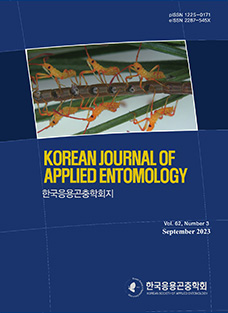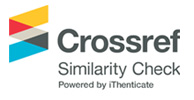The subfamily Platypodinae had been recorded 6 species in 4 genera in Korean peninsula up to now (Park and Lyu, 2007, Park and Hong, 2018). In the present study, three newly recorded species of Platyponidae to Korean fauna are recognized based on morphological studies: Crossotarsus niponicusBlandford, 1894, Platypus contaminatus (Blandford, 1894) and P. quercivorus (Murayama, 1925). The species Platypus quercivorus is closely related to P. koryoensis (Murayama, 1930), which is known as a vector for oak wilt disease. This species is also recognized as a vector for oak wilt disease in Japan (Hong et al., 2006). On the Korean Peninsula, all individuals of Platypus koryoensis are occurred only in the mainland, whereas both P. quercivorus and Crossotarsus niponicus are found only on Is. Ulleung, while Platypus contaminatus occurs only on Is. Jeju. We provide the brief diagnosis and information on the species and their photographic images.
Materials and Methods
Examined specimens were collected with the multi-funnel trap (Synergy semiochemicals Cor., Canada) or by naked eye. The voucher specimens are deposited in the collection of Research Institute of Forest Insect Diversity (RIFID, Namyangju, Korea) and National Institute of Biological Resources (NIBR, Incheon, Korea). The important morphological characters were studied using a stereoscopic microscope (S8Apo, Leica, Heerbrugg, Switzerland). Photographs were taken with Canon 5D digital camera and Canon Macro Photos Lens MP-E 65 (Canon, Tokyo, Japan). Multiple images were stacked using Helicon Focus version 8.2.0.
Taxonomic accounts
Order Coleoptera 딱정벌레목
Family Curculionidae 바구미과
Subfamily Platypodinae 긴나무좀아과
Tribe Platypodini Shuckard, 1840 긴나무좀족
Genus CrossotarsusChapuis, 1865 가시나무긴나무좀속
CrossotarsusChapuis, 1865: 23 (Type species Platypus wallacei J. Thomson, 1857)
CrossotarsinulusSchedl, 1972: 84 (Type species Crossotarsus sauteriStrohmeyer, 1913)
Crossotarsus niponicusBlandford, 1894 배외긴뿔나무좀 (신칭) (Fig. 1A-B, L)
Crossotarsus niponicusBlandford, 1894: 130 (Type locality: Japan).
Diagnosis. Body length 5.3-6.3mm, cylindrical and reddish brown.
Male. Head with front flattened, shortly pubescent and dull with scattered punctation. Antennal scape tetragonal and asymmetrically expanded. Vertex with a median shining line. Prothorax longer than wide, lateral emargination distinct, slightly impressed on either side at behind middle of surface. Elytra shining, finely striated at basal area. Basal three fourth area of elytra glabrous without setae. Declivital area of elytra with golden short hairs. Posterolateral area of declivity serrated with minute tubercles and with one distinct and acute process at each side of postal margin. First ventrite with a distinct process directed posteriorly at middle.
Female. Posterolateral process of declivity short and slightly blunt. Process of first ventrite smaller but distinctly acute.
Specimens examined. 3♂♂4♀♀, Nari, Buk-myeon, Ulreunggun, Gyeongsangbuk-do, 25.v.2023. S. Park.
Distribution. Korea (Is. Ulreung: New record), Japan, Taiwan.
Genus PlatypusHerbst, 1793 참긴나무좀속
PlatypusHerbst, 1793: 128 (Type species: Bostrichus cylindrusFabricius, 1792)
CylindraIlliger, 1802: 303 [URN] (Type species: Bostrichus cylindrusFabricius, 1792)
PlatypinusSchedl, 1939: 397 [NA]
StenoplatypusStrohmeyer, 1914: 35 (Type species: Crossotarsus spinulosusStrohmeyer, 1912)
Platypus contaminatus (Blandford, 1894) 이승악긴나무좀 (신칭) (Fig. 1E-F, P)
Crossotarsus contaminatusBlandford, 1894: 131 (Type locality: Japan).
Diagnosis. Body length 5.0-5.3mm, cylindrical and reddish brown.
Male. Head with weakly concave frons, shortly pubescent and dull with scattered punctation. Antennal scape triangular and asymmetrically expanded. Vertex with a median shining line and two indistinct lateral lines. Prothorax longer than wide and lateral emargination feeble, slightly impressed on either side at middle of surface. Elytra shining, finely striated at basal area. Basal three fourth area of elytra glabrous without setae. Postal area with golden short hairs.
Female. Pronotum with a small but distinct patch of mycangial punctures at behind middle. Elytral declivity slightly narrowed and blunt.
Specimens examined. 1♂, Sinrye-ri, Namwon-eup, Seogwipo-si, Jeju-do, 9.viii-12.ix.2022, S. Park; 3♀♀, Sinrye-ri, Namwoneup, Seogwipo-si, Jeju-do, 2.iv-11.v.2023, S. Park; 2♀♀, Si-oreum, Seoho-dong, Seogwipo-si, Jeju-do, 17.iv-16.v.2024, S. Park.
Distribution. Korea (Is. Jeju: new record), Japan, China, Taiwan.
Platypus quercivorus (Murayama, 1925) 닮은긴나무좀 (신 칭) (Fig. 1C-D, M-O)
Crossotarsus quercivorusMurayama, 1925: 229 (Type locality: Japan).
Crossotarsus sexfenestratusBeeson, 1937: 94 (Type locality: India).
Crossotarsus brevidensBrowne, 1975: 302 (Type locality: Thailand).
Diagnosis. Body length 4.0-5.2mm. Body cylindrical and reddish brown.
Male. Head with front flat, shortly pubescent and dull with scattered punctation. Antennal scape triangular and asymmetrically expanded. Antennal club round, flat and clearly expanded. Vertex with a median shining line and two indistinct lateral lines. Prothorax longer than wide and shining without hairs except outline of pronotum. Pronotum irregularly punctate and lateral emargination feeble, slightly impressed on either side at middle of surface. Elytra shining, finely striated at basal area. Basal four fifth area of elytra glabrous without setae. Postal area with golden short hairs. Each elytral interval convex at apical declivity. Elytral declivity slightly narrowing posteriorly and angulated at sides. Apical area of declivity with tubercles.
Female. Pronotum with three to five round mycangial pores on each side of median sulcus without distinct punctures around mycangial pores. Elytral declivity slightly narrowed and abruptly blunt at postal margin.
Specimens examined. 2♂♂3♀♀, Nari, Buk-myeon, Ulreunggun, Gyeongsangbuk-do, 24.vii-8.ix.2023, S. Park.
Distribution. Korea (Is. Ulreung-new record), Japan, Russia (Far East), India, Thailand, Taiwan, Austrailian Region, Oriental Region.
Remarks. This species is quite similar to P. koryoensis, but it can be easily distinguished by the shape of the first projection on the elytral declivity, the apex of the elytra, and the shape of the hind coxa in males. The first projection on the male's elytra is dull and extends to the apex. Each side of the apex is wide and clearly carinate. In females, the apex of the elytra is more broadly and shallowly truncated compared to P. koryoensis (Fig. 1G-K). In particular, the pronotum of P. quercivorus in females lacks dense punctures around the mycangial pores, whereas P. koryoensis has numerous dense punctures in this area. The differences between them are clearly evident in body length, pronotum shape, elytral declivity, and the hind coxal process (Hong et al., 2006).








 KSAE
KSAE





